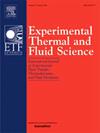Mach–Zehnder interferometry for fluid physics experiments involving contact lines and phase change
IF 3.3
2区 工程技术
Q2 ENGINEERING, MECHANICAL
Experimental Thermal and Fluid Science
Pub Date : 2025-08-11
DOI:10.1016/j.expthermflusci.2025.111579
引用次数: 0
Abstract
Mach–Zehnder interferometry is a powerful optical technique for investigating thermo-fluidic phenomena, particularly in experiments involving contact line and phase change measurements. This study presents a comprehensive experimental framework leveraging Mach–Zehnder interferometry to analyze liquid film thickness profiles, vapor concentration fields (vapor clouds), and concentration fields in a Hele-Shaw cell. The technique is applied to sessile droplet profilometry on transparent substrates, revealing wetting dynamics, contact angle evolution, and Marangoni-driven flows and instabilities in spreading and evaporating droplets. Apart from volatile pure droplets, where the thermal Marangoni effect may be essential on account of evaporative cooling, the study also explores the role of solutal Marangoni stresses in hygroscopic binary mixtures. Additionally, vapor interferometry is employed to quantify the concentration field above evaporating droplets and liquid pools, demonstrating the method’s capability for non-invasive measurement of evaporation rates. We also showcase the application of interferometry in dissolution studies within Hele-Shaw cells. The results highlight the versatility of Mach–Zehnder interferometry in capturing all those complex phenomena, offering valuable insights for the study of evaporation, wetting, and mass transport in confined geometries.
涉及接触线和相位变化的流体物理实验的马赫-曾德尔干涉测量
马赫-曾德干涉测量法是一种强大的光学技术,用于研究热流体现象,特别是在涉及接触线和相变测量的实验中。本研究提出了一个综合的实验框架,利用马赫-曾德干涉法来分析Hele-Shaw电池中的液膜厚度分布、蒸汽浓度场(蒸汽云)和浓度场。该技术被应用于透明基底上的液滴轮廓测量,揭示了湿润动力学、接触角演变、马兰戈尼驱动的流动和液滴扩散和蒸发的不稳定性。除了挥发性纯液滴之外,由于蒸发冷却,热马兰戈尼效应可能是必不可少的,该研究还探索了溶质马兰戈尼应力在吸湿二元混合物中的作用。此外,采用水蒸气干涉法对蒸发液滴和液池上方的浓度场进行了量化,证明了该方法具有无创测量蒸发速率的能力。我们还展示了干涉测量法在Hele-Shaw细胞内CO2溶解研究中的应用。结果突出了马赫-曾德尔干涉测量法在捕获所有这些复杂现象方面的通用性,为研究密闭几何中的蒸发、润湿和质量传输提供了有价值的见解。
本文章由计算机程序翻译,如有差异,请以英文原文为准。
求助全文
约1分钟内获得全文
求助全文
来源期刊

Experimental Thermal and Fluid Science
工程技术-工程:机械
CiteScore
6.70
自引率
3.10%
发文量
159
审稿时长
34 days
期刊介绍:
Experimental Thermal and Fluid Science provides a forum for research emphasizing experimental work that enhances fundamental understanding of heat transfer, thermodynamics, and fluid mechanics. In addition to the principal areas of research, the journal covers research results in related fields, including combined heat and mass transfer, flows with phase transition, micro- and nano-scale systems, multiphase flow, combustion, radiative transfer, porous media, cryogenics, turbulence, and novel experimental techniques.
 求助内容:
求助内容: 应助结果提醒方式:
应助结果提醒方式:


